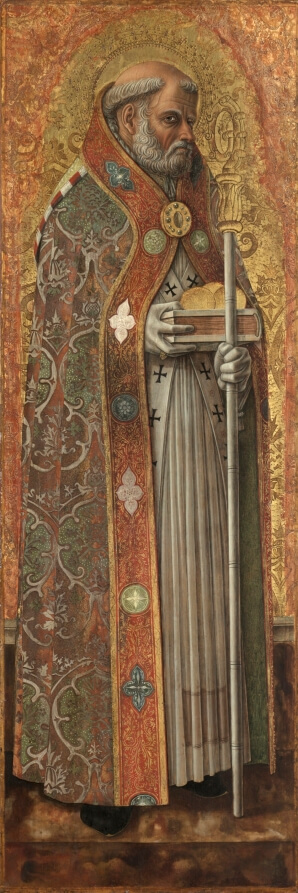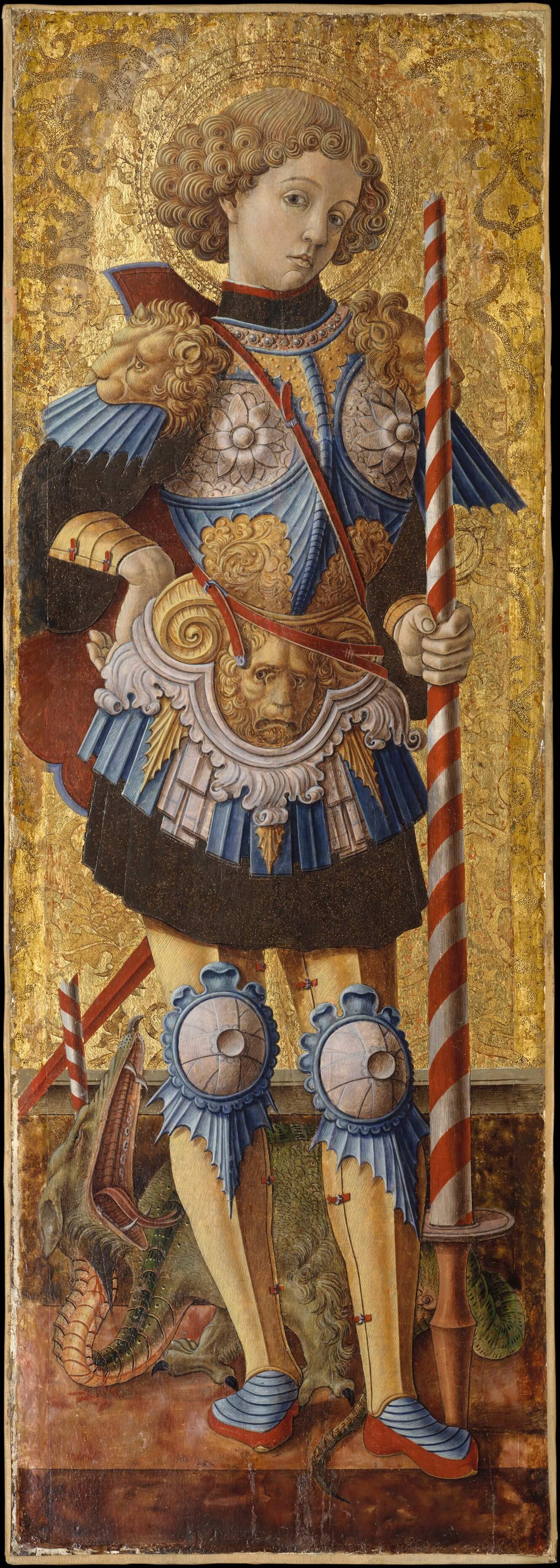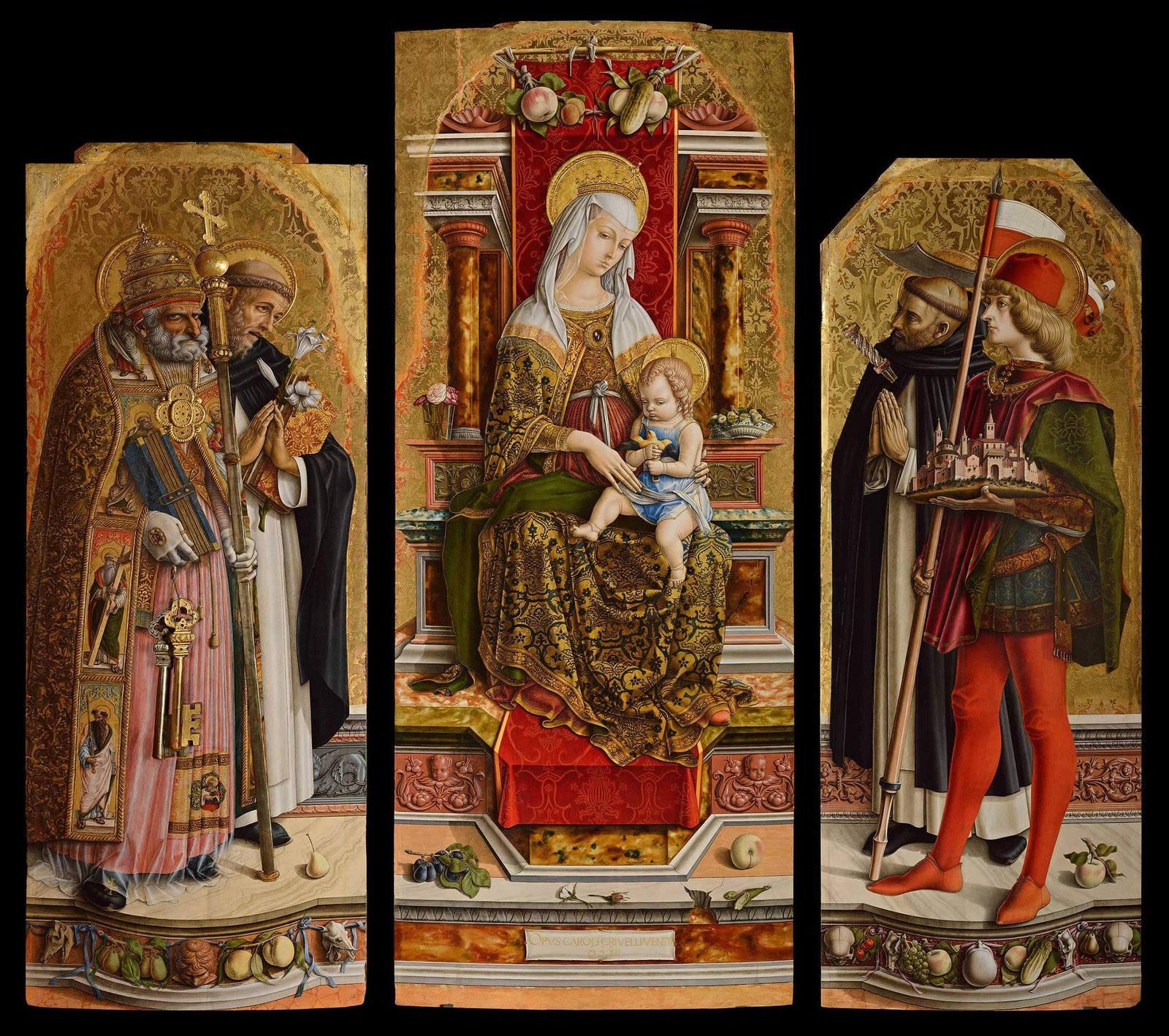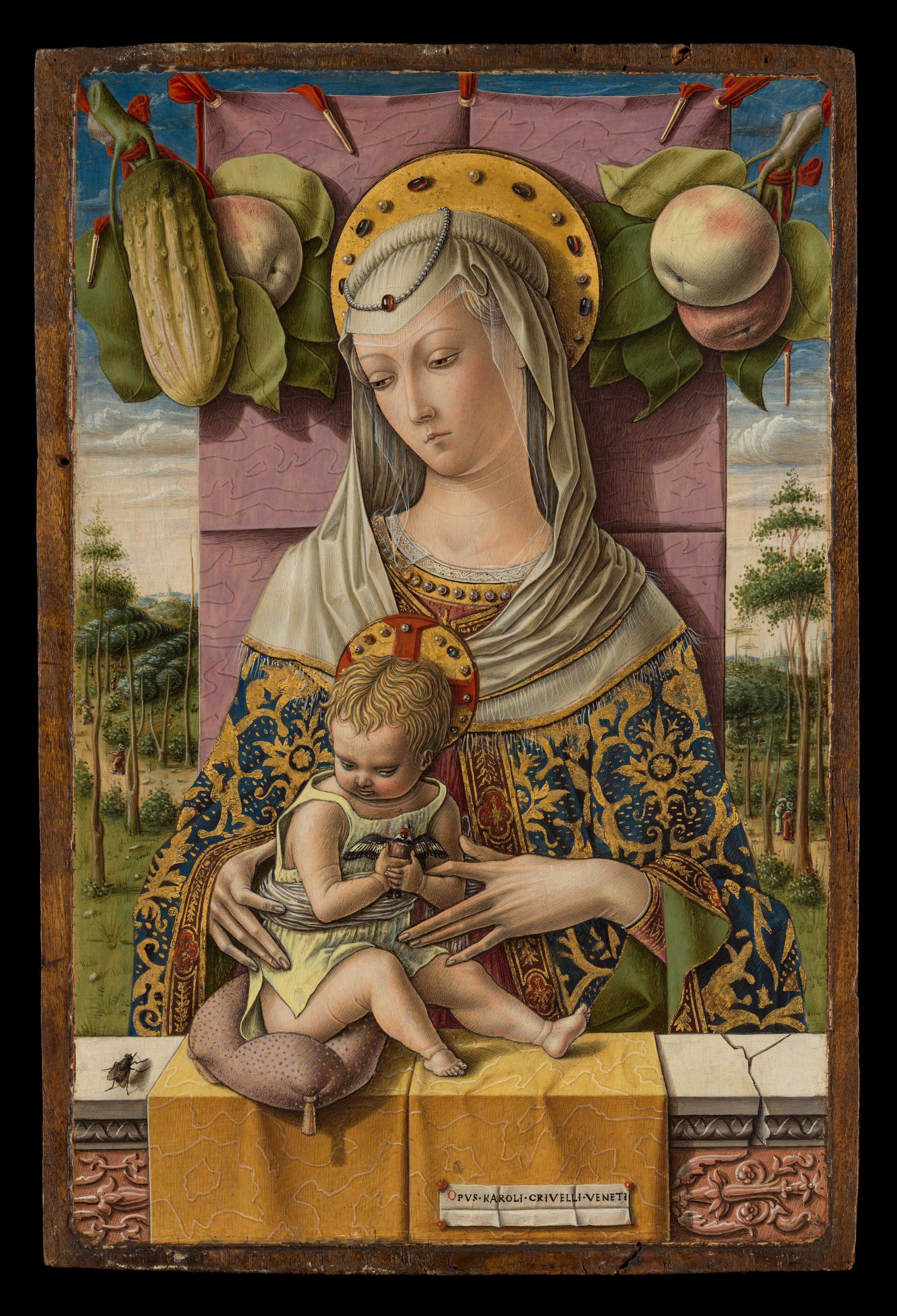Continuing the Christmas tradition I started last year with Fra Angelico, I want to introduce another early Renaissance painter of gorgeous religious figures. Carlo Crivelli (1430-1495) painted sumptuously-dressed Madonnas and saints in an appealing style that’s part Gothic and part Renaissance, with more than a hint of Byzantine icon painting. Copious gilding, crisp lines, and vivid colors characterize his beautiful and rich artworks. They remind me of Christmas decorations in the best possible way.

Carlo Crivelli was born and raised in Venice, then a center of artistic activity. He trained with his artist father and also with painters from Padua. Exiled from Venice in his twenties, Crivelli spent most of his career in the central Italian region known as The Marches. He was exclusively a religious painter, creating both private devotional paintings and large altarpieces. Like so many other multi-panel altarpieces, Crivelli’s have since been broken up, scattering their figures to museums across the world.
Crivelli’s Style
Crivelli combined Renaissance naturalism with decorative patterns characteristic of Gothic art. His paintings are supremely illusionistic in places but rather flat in others. The effect is slightly surreal, as though representing a world that isn’t quite the same as ours. His brilliant colors – he used both tempera and oil, sometimes on the same panel – and sharp, clean lines contribute to this air of hyper-reality. Crivelli had an incredible eye for detail. He filled his paintings with opportunities to use his impressive skill at rendering fabrics, jewels, and other textures. His are among the best dressed religious figures I’ve ever seen, and they inhabit some of the most stylish dwellings, too! Beyond being merely showpieces, however, objects like the ointment jar carried by Mary Magdalen (bottom of page) also have symbolic meanings. He used the cucumber as his visual signature, including it in the garlands he loved to paint above Madonna and Child images like some of those shown here.
Paintings like Saint George Slaying the Dragon and The Annunciation with Saint Edimius (above) clearly demonstrate Crivelli’s skill in foreshortening and linear perspective. At the same time, there’s a slight flatness to his forms. His subjects’ faces are rather generic and their postures perhaps a bit vague. It’s not that his figures look awkward or unbelievable in any way. On the contrary, I find them to be quite elegant and harmonious, but it seems that Crivelli was content to suggest three-dimensionality without fully realizing it. The textures of stone, silk, and glass obviously captured his interest more than human figures did.
When he adapted Renaissance themes he transposed them into stylized and imaginative visions, the forms outlined by sharp, clear drawings and often emphasized by richly tooled hold grounds.
Zeri, Federico with Elizabeth E. Gardner. Italian Paintings: A Catalogue of the Collection of The Metropolitan Museum of Art. Vol. 2, Venetian School. New York: The Metropolitan Museum of Art, 1973. P. 21.

Crivelli used gold leaf prolifically, and some of his works have also received additional gilding later. He often employed the Gothic convention of setting his figures on a gold background, even though so-called “gold ground paintings” were definitely out of fashion by his time. Look closely, and you’ll notice that the gilding is tooled to create elaborate surface patterns. This tooling would have appeared to its best possible advantage when illuminated by candlelight in a Renaissance church. Crivelli also used a technique called pastaglia. In this process, the artist modelled raised forms in gesso (a plaster-based glue) and then gilded those areas. The effect is that of a glittering mini relief sculpture in the middle of the flat paint surface. Crivelli used pastaglia for things like crowns and sword hilts, and he covered it in paint to form convincing jewels. Unfortunately, the effects of pastaglia don’t show up all that well in photographs.
Although I’ve chosen to spotlight Crivelli’s most cheerful paintings here – I always focus on the pretty and pleasant at Christmas – he also painted Lamentations, Pietas, and Crucifixions. These scenes often featured characters with intensely and even grotesquely expressive faces. Scholars see the influence of Crivelli’s contemporary Andrea Mantegna (c. 1431-1506) in these highly emotional works.
Reputation

Because he had one foot in the Middle Ages and the other in the Renaissance, Carlo Crivelli doesn’t fit comfortably into the customary art historical timeline. (You’ll understand why when you compare his works to Michelangelo’s famous Sistine Ceiling, painted only a few decades after Crivelli’s death.) He connects to the traditions of Venice and Padua but doesn’t really belong to any artistic lineage. Some scholars want to consider him an antiquated Gothic remnant, but I find that characterization unfair. He looked to the past, but I don’t think he was completely stuck in it.

To me, Crivelli is the perfect blend of Medieval and Renaissance. His works celebrate everything I love about medieval art, especially the rich colors and eye-catching decoration, alongside incredibly graceful and naturalistic forms. Crivelli’s works are stylized, yet beautifully and perhaps intentionally so; they lack the awkwardness or naiveté modern eyes often perceive in medieval or proto-Renaissance art. Some scholars have compared Crivelli’s crisp, detailed style to northern European artists like Jan Van Eyck (active 1422-1441). Although I definitely see the similarities, I also sense a unique and compelling poetry in Crivelli’s work that I’ve never found anywhere else. His lines are sharp, but his tone is soft somehow. I was not surprised to learn that the Pre-Raphaelites loved him, as they shared his boldness of form and love of abundant detail.
Crivelli wrested the inherent contradictions of his art into balanced wholes that are deliciously accessible as images and unexpectedly familiar as bold statements of ambition.
Smith, Roberta. “Carlo Crivelli, an Overlooked Renaissance Master, in Boston“. The New York Times. November 5, 2015.

Art history has long struggled on what to do with Crivelli, and that’s understandable. His reputation suffered from the fact that Giorgio Vasari didn’t include him in his famous The Lives of the Most Excellent Painters, Sculptors, and Architects, which established the art historical canon. Fortunately, some later connoisseurs appreciated him a bit better. Bernard Berenson advised Isabella Stewart Gardner to purchase Saint George Slaying the Dragon, which was the first Crivelli in the United States, and Roger Fry acquired two of his saints for the Met around the turn of the 20th century. (I first discovered Crivelli while researching my thesis on Fry.) However, he is still excluded from major art history books, as evidenced by the fact that a search of my bookshelf turned up only a single, passing mention. He fairs better on the internet, largely thanks to a 2015-16 exhibition at the Isabella Stewart Gardner Museum. I highly recommend visiting the Gardner’s excellent website for the show, which provides lots of information and high-resolution photographs with handy magnification features. The exhibition also produced a lengthy book about Crivelli, which I plan to acquire in the near future.
I hope that you have enjoyed my second annual article about Italian Renaissance painters perfect for Christmastime. I’ve been fascinated by Carlo Crivelli for a while now, and I’m so glad I finally got to learn more about him and share my appreciation with all of you. Merry Christmas and Happy Holidays to everybody!

Sources
- “Carlo Crivelli“. National Gallery, London.
- “Ornament & Illusion: Carlo Crivelli of Venice“. Isabella Stewart Gardner Museum, 2015.
- “Saint Nicholas of Bari“. Cleveland Museum of Art website.
- Hickson, Sally. “Carlo Crivelli, The Annunciation with Saint Emidius“. Smarthistory, June 15, 2020.
- Kilroy-Ewbank, Lauren & Steven Zucker. “Do You Speak Renaissance? Carlo Crivelli, Madonna and Child“. Smarthistory, December 29, 2019.
- Smith, Roberta. “Carlo Crivelli, an Overlooked Renaissance Master, in Boston“. The New York Times. November 5, 2015.
- Various authors. The Jack and Belle Linsky Collection in the Metropolitan Museum of Art. New York: The Metropolitan Museum of Art, 1984. P. 29-32.
- Zeri, Federico with Elizabeth E. Gardner. Italian Paintings: A Catalogue of the Collection of the Metropolitan Museum of Art. Vol. 2, Venetian School. New York: The Metropolitan Museum of Art, 1973. P. 21-25.
Further Reading
Campbell, C. Jean et al. Ornament and Illusion: Carlo Crivelli of Venice. Boston: Isabella Stewart Gardner Museum, 2015.

